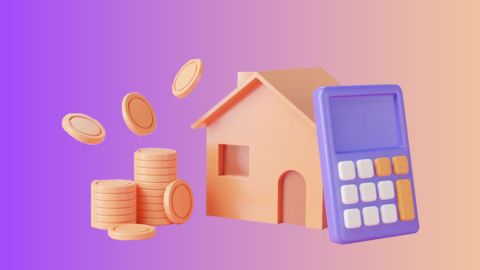What is a home loan EMI calculator?
A home loan EMI calculator is an online tool that allows you to estimate your Equated Monthly Installment (EMI) based on key inputs such as loan amount, interest rate, and tenure. By using this calculator, you can get a clear understanding of your repayment schedule and plan your finances accordingly.
For example, if you calculate your EMIs using the Bajaj Finserv Home Loan EMI Calculator, you can determine your potential monthly outflow. Based on an interest rate starting from 8.25%* p.a per annum, the EMI for a loan amount of ₹1 lakh can be as low as Rs. 741/lakh*, depending on the selected tenure.
Using this tool, you can experiment with different loan amounts and tenures to find an EMI that fits your budget. It also helps you assess your repayment capacity before applying for a home loan, ensuring informed financial planning.
What is a home loan EMI?
A Home Loan EMI (Equated Monthly Installment) is a fixed amount that a borrower pays each month towards repaying a home loan. It consists of both principal repayment and interest payment calculated over the loan tenure. This amount is predetermined based on the loan amount, interest rate, and loan tenure.
How to use Bajaj Finserv Home Loan EMI Calculator?
Here are 3 ways you can calculate your home loan EMI:
1. Use Bajaj Finserv Home Loan EMI Calculator
Here are the steps to calculate your home loan EMIs using our home loan EMI calculator:
- Enter the loan amount: Input the total amount you wish to borrow as a home loan.
- Select the interest rate: Specify the interest rate offered.
- Set the loan tenure: Choose the repayment tenure for your home loan.
- View your results: Instantly, the calculator will display your EMI amount, total interest payable, and the total payment (principal + interest).
- Adjust as needed: Experiment with different values for the loan amount, interest rate, or tenure to find an EMI plan that fits your budget.
2. Manual home loan EMI calculation
Home loan EMI calculation formula
EMI = P x R x (1+R)^N / [(1+R)^N-1]
where, P = Principal amount, N = Loan tenure in months, and R = Monthly interest rate
Home loan EMI calculation example
If the annual rate of interest is 8.5%, the value of ‘R’ will be 8.5/ (12 x 100) = 0.00708
On availing of a housing loan of Rs. 40 lakh at an annual interest rate of 8.50% for a tenure of 240 months (20 years), the EMI will be calculated as:
EMI = 40,00,000 * 0.00708 * (1 + 0.00708)^240 / ((1 + 0.00708)^240 - 1) = Rs. 34,713
Calculation for Rs. 40 lakh home loan
Principal loan amount |
Rs. 40 lakh |
Home loan interest rate |
8.50% p.a. |
Tenure |
20 Years |
EMI |
Rs. 34,713 |
Total interest paid |
Rs. 43,31,103 |
Total payable amount (EMI * tenure in months) |
Rs. 83,31,103 |
Factors that Affect Your Home Loan EMI
1. Principal Amount
The principal amount is the loan amount you borrow from the lender. A higher principal directly increases your Equated Monthly Installment (EMI) since the total repayment amount (including interest) will be higher. Conversely, opting for a lower loan amount reduces the EMI, making it more affordable.
2. Rate of Interest
The rate of interest significantly impacts your EMI, as it determines the cost of borrowing. A higher interest rate increases the total repayment amount, leading to a higher EMI. On the other hand, a lower interest rate reduces your EMI burden. Choosing a lender with a competitive rate or opting for a floating interest rate can help in managing EMIs effectively.
3. Loan Tenure
The tenure or repayment period affects the EMI amount inversely. A longer tenure reduces the monthly EMI, making repayment easier, but increases the total interest paid over time. A shorter tenure results in a higher EMI but helps in repaying the loan faster with lower total interest outflow. It’s essential to balance tenure and EMI to ensure financial stability.
How Can EMI Calculation Help You Plan Your Dream Home?
Planning your dream home requires careful financial assessment, and an EMI calculator for home loan can be a valuable tool in this process. By using a housing loan EMI calculator, you can estimate your monthly payments based on the loan amount, interest rate, and tenure. This helps you manage your finances better, ensuring that your EMI fits within your budget without straining your expenses. Additionally, knowing your EMI in advance allows you to compare different loan offers, choose the best repayment plan, and make an informed decision about your home purchase.
Benefits of our home loan calculator
Our home loan calculator is designed to simplify your financial planning by providing accurate EMI calculations. Here are the key features and benefits:
- Ease of use: The calculator is user-friendly, requiring minimal input to generate precise EMI figures. Simply enter the loan amount, interest rate, and tenure to get instant results.
- Financial planning: Understand the total interest payable over the loan tenure, enabling better financial planning and management of other expenses.
- Time-saving: Quickly calculates EMIs without the need for complex manual computations, saving you valuable time and effort.
- Transparency: Offers a clear breakdown of principal and interest components, ensuring transparency in your financial commitments.
Using our home loan calculator, you can make informed decisions, ensuring a smoother and more manageable home loan experience.
Frequently asked questions
As the term rightly suggests, Equated Monthly Instalments (EMI) are due every month, and gradually reduce the principal borrowed throughout the selected tenure. You are obligated to pay your housing loan EMI on a fixed date every month, which is set at the time of loan disbursal. Missing an EMI payment could lead to penal charges, and will also impact your credit score.
Housing loans are one of the most flexible credit options that are available to borrowers, to fund the purchase of a residential property. Often, depending on the borrower’s requirements, the lender can disburse the home loan amount in parts. Till the full loan amount isn’t disbursed to you, you are required to repay only the interest component of the principal loan amount. The amount you pay as the home loan EMI in the meanwhile is also called a home loan pre-EMI.
Borrowers only start paying full home loan EMIs, once the home loan principal amount is fully disbursed to them. Typically, a home loan tenure can stretch up to 30 years, giving borrowers the flexibility of choosing a repayment schedule as per their convenience.
A home loan is a tax-benefit credit option, which is also why many choose to buy a second property as an investment – allowing them to avail of home loan tax benefits through their second home loans as well. There are several tax benefits and concessions attached to paying home loan EMIs, such as:
Section 80C: You can claim a tax rebate on the principal component of your home loan EMI, up to Rs. 1.5 lakh every year
Section 24(b): You can claim a tax rebate on the interest component of your home loan EMI, up to Rs. 2 lakh every year
Section 80EE: You can claim a tax rebate on the interest component of your home loan, after you have exhausted the claimed cap under Section 24(b), up to Rs. 50,000, only if you are a first-time home buyer
You can calculate total tax payable based on your taxable income, expenses, age, investments and interest paid towards your home loan through income tax calculator.
Home loan repayment refers to the process of paying back your entire loan (principal plus interest) to the lender over the agreed-to timeframe. Your repayment primarily depends on the selected tenure and the timely payment of your Equated Monthly Instalments (EMI). Your EMI amount depends on the loan amount, the tenure chosen, and the home loan interest rate.
To repay your loan earlier than planned, you will need to make part prepayments or completely foreclose the loan with one lump sum payment. In case you have surplus funds and choose to become debt-free sooner, use our home loan foreclosure calculator to know the sum payable. This is important as a home loan is a sizable sum, which necessitates planning and research.
There are several ways in which borrowers can reduce their home loan EMIs, with Bajaj Finserv. Eligible applicants who meet the home loan criteria can benefit from lower interest rates and longer tenure – bringing down their total cost of borrowing. Here are a few ways to help reduce home loan EMIs:
- Scale up your down payment amount
- Focus on boosting your credit profile and CIBIL score
- Ensure maximum repayment capacity
- Pay off all pending dues and obligations
- Apply with a co-applicant to enhance your home loan application
- Select the right property that passes the lender’s verification
You can also avail of a home loan balance transfer and transfer your pending home loan balance to Bajaj Finserv and repay the rest of your loan amount at a reduced EMI.
An error-free and easy way to calculate interest on your home loan is by using the home loan EMI calculator. All you must do is open the home loan interest rate calculator tool available on the Bajaj Finserv website and enter the fields such as the interest rate, principal amount, and tenure. When you enter all the values correctly, you will not only find out the amount you will pay as interest but also the EMIs and the total loan payable by the end of your tenure.
The part-prepayment facility on your home loan helps you to reduce your home loan EMIs. By making part-prepayments, you can save substantially on the overall interest payment, as you repay the full amount well before the end of the repayment tenure and you can calculate it through home loan prepayment calculator.
Existing home loan borrowers and new ones all have the same question, which is – what will bring down the cost of borrower faster – smaller EMIs, or a short tenor? There are several points to consider while making that choice.
A home loan is a sizeable financial commitment and taking on one could mean that you will be repaying the loan amount for almost 25 to 30 years of your life. While the home loan repayment is still feasible and can continue along with your other financial developments, one can choose to repay their home loan faster, if their budget and repayment capacity allows for it. Here are two ways to do it:
The amount you pay as home loan EMI is made up of the home loan principal and home loan interest in parts. However, where you stand in your repayment tenure also plays a role in deciding how much of the home loan EMI is composed of the principal amount and how much is the home loan interest.
If you wish to see your EMI break-up, you can do so in two ways:
- Manual calculations
- Home loan EMI calculator
Manual calculations have a wider margin of error, as the formula is complex, and with bigger numbers, one may make mistakes in the calculations. Here is the formula to calculate the same:
Interest component = P x R
Where,
P is the pending principal loan amount
R is the home loan interest rate
And then, you can subtract the interest amount out of the EMI, to arrive at the principal component.
To complete these calculations without any errors, make use of an EMI calculator and get error-free results in seconds.
Your home loan Equated Monthly Installments (EMIs) start from the month following the disbursement of the loan amount. The exact date depends on your lender’s terms and conditions.
If your loan is disbursed in full, the EMI payment begins from the next month. However, if the loan is disbursed in parts (such as in under-construction properties), you may need to pay pre-EMI interest on the disbursed amount until full disbursement. Once the entire loan amount is disbursed, your regular EMI payments commence as per the agreed schedule.
An EMI calculator simplifies home buying planning by providing instant calculations of Equated Monthly Installments (EMIs) based on loan amount, interest rate, and tenure. This allows prospective buyers to assess affordability, plan budgets accurately, and explore various loan options before committing to a purchase. By offering quick insights into repayment amounts, an EMI calculator aids in making informed decisions, ensuring that borrowers choose home loans that align with their financial capabilities and goals.
Here are steps to calculate:
- Open Excel and select a cell to display the EMI.
- Use the formula "=PMT(interest rate/12, tenure in months, loan amount)".
- Replace "interest rate" with your loan's annual interest rate.
- Divide the annual interest rate by 12 to get the monthly rate.
- Replace "tenure in months" with the loan tenure in months.
- Multiply the loan tenure by 12 to convert it into months.
- Replace "loan amount" with the total loan amount.
- Press Enter, and Excel will calculate the monthly EMI.
- Review the result to plan your finances accurately for your home loan.
The EMI amount is usually fixed for the entire loan tenure if you opt for a fixed interest rate. However, if you have a floating interest rate, your EMI may change based on market fluctuations. Additionally, factors like prepayments or a loan restructuring can also impact your EMI. You can use a home loan EMI calculator to estimate different scenarios and plan your finances accordingly.
Home loan EMIs offer tax benefits under the Income Tax Act. The principal repayment qualifies for a deduction of up to ₹1.5 lakh per year under Section 80C, while the interest paid is eligible for a deduction of up to ₹2 lakh under Section 24(b). If you have taken a home loan for an under-construction property, the interest paid during the construction period can be claimed in five equal installments after possession.
Yes, you can request a change in your home loan EMI date, subject to the lender’s policies. To modify the EMI date, you need to contact your lender and submit a formal request. Some lenders may charge a nominal fee for this service. It’s advisable to check with your bank or financial institution regarding their specific process, as changes in EMI dates could impact your repayment schedule and cash flow planning.
Part or subsequent disbursement occurs when a home loan is disbursed in multiple installments instead of a lump sum. This is common for under-construction properties, where the lender releases funds as per the project’s progress. Borrowers are charged interest only on the disbursed amount until the full loan is sanctioned. This approach ensures funds are utilized efficiently and helps in managing the repayment burden effectively.
Pre-EMI interest is the interest paid on the disbursed loan amount before the full loan is sanctioned. It applies primarily to under-construction properties, where lenders release funds in phases. During this period, you only pay interest, and the actual EMI payments begin after full disbursement. This helps reduce the financial burden in the early stages but may increase the total interest paid over the loan tenure.
A home loan amortization schedule is a detailed table illustrating the repayment process of a home loan over time. It outlines each periodic payment, breaking down the principal amount, interest component, and remaining balance. The schedule spans the entire loan tenure, showcasing how each payment contributes towards reducing the outstanding loan balance. It aids borrowers in understanding their repayment journey, including the gradual decrease in interest payments and the gradual increase in principal repayments as the loan progresses.








